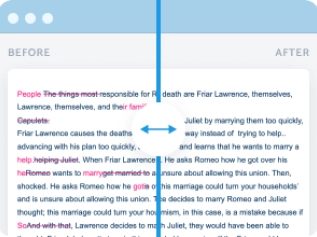False Cause Fallacy: Definition & Real-Life Examples
Table of contents
Have you ever heard someone say, “Every time I wear my lucky socks, we win the game”? Or, “After the new mayor took office, crime went up”? These are examples of a false cause fallacy. People often link two events and assume one led to the other. But just because something happens after another thing doesn’t mean it’s the reason why.
In everyday conversations, news stories, and debates, we always see this thinking. It may sound convincing, but it’s often wrong. This article will help you understand what a false cause fallacy is in practice, its main types, and how to spot it.
You’ll also see real-life false cause fallacy examples and learn how to avoid making this mistake in your arguments.
If you need arguments written with flawless logic and structure, checking reviews for the best assignment writers can be a wise choice.
What Is the False Cause Fallacy?
This term refers to an improper conclusion that appears when we assume one event causes another without solid proof.
It can also show up when we:
- Mix up cause and effect (reverse the order);
- Oversimplify complex events;
- Jump to conclusions without enough evidence.
Important: Just because this fallacy occurs doesn’t mean the conclusion is false. It’s only because there’s insufficient evidence to prove it.
Why It Matters?
This kind of thinking can lead to weak arguments and false conclusions.
It’s also known as:
- Non causa pro causa;
- Questionable cause;
- Faulty causality.
🧠 It’s one of the most common informal logical fallacies.
To better understand this, it helps to distinguish between correlation and causation. The image below shows how two events can happen without causing each other, a key idea behind the false cause fallacy.
Correlation ≠ Causation
Sometimes, two things happen at the same time or one right after the other. But just because they’re time-linked doesn’t mean one caused the other.
This confusion lies at the heart of the false cause fallacy.
Quick distinction:
- Correlation: Events happen together or close in time.
- Causation: One event actually produces the other
Let’s consider some false cause fallacy examples in real life.
🔸 Ice cream and sunburns:
Ice cream sales go up in summer. So do sunburns.
Does eating ice cream cause sunburn? No.
Shared factor: Hot weather.
🔸 Lucky bracelet:
Someone wears a bracelet, and good things happen.
They believe the bracelet brings luck.
Reality? Coincidence or other reasons.
Accordingly, faulty causality occurs when we see a cause-and-effect link that isn’t really there. This mistake can weaken our arguments and lead to wrong ideas.
5 Key Types of False Cause Fallacy
Faulty causality is a broad term for mistakes in thinking about reason and effect. There are several essential types of incorrect causal links. Understanding these helps us spot errors in reasoning more clearly.
1. Post Hoc Ergo Propter Hoc.
This Latin phrase means “after this, therefore because of this.” It’s also known as the post hoc fallacy. This mistake happens when someone thinks that the first event must have led to the second just because one event happened before another. But in reality, things are not always connected like that.
| Examples:
In sports, if a team wins after changing its coach, the new coach brings the win. But maybe the team was already improving, or the other team played badly. In school, if a student gets better grades after buying a new notebook, it doesn’t mean the notebook leads to improvement. The student might have studied more or understood the lessons better. In politics, if a new law is passed and the economy improves, the law triggers growth. However, other factors, such as global markets or new technology, could be responsible. |
This fallacy is important to understand when choosing strong arguments. If you want to write good topics for argumentative essay, avoid assuming one event triggers another just because it came first. Always look for real proof and reasons behind the events.
2. Cum Hoc Ergo Propter Hoc.
This Latin phrase means “with this, therefore because of this.” It describes a common mistake when people assume that if two things happen at the same time, one must spark the other. But just because things happen together doesn’t always mean they are connected or that one results in another.
| Examples:
In terms of food and health, someone might notice that people who eat a lot of ice cream also get sunburned more often. They might think ice cream creates sunburn. But really, both happen more often during hot, sunny weather. In school, if a student who does his homework while playing music gets good grades, someone might say that listening to music leads to better grades. However, the student is motivated and studies well, no matter what. |
This kind of mistake can lead to wrong conclusions. It’s important to remember that just because two things happen at the same time doesn’t mean one causes the other. Look deeper to find the real reasons behind what you observe.
3. Oversimplification.
Oversimplification happens when someone takes a complicated problem and tries to explain it with just one simple reason. This can make things seem easier to understand, but it often ignores many other important factors that play a role. Knowing how to write a conclusion paragraph for an argumentative essay can help you avoid oversimplification by addressing multiple points and wrapping up your argument thoughtfully.
| Examples:
People might say, “Students fail because they’re lazy.” But the truth is, academic struggles often have many causes. Learning disabilities, family stress, a lack of resources, or even teaching methods can all affect student performance. Another common example is when a company fails and people say, “It’s all because of bad management.” While poor management can be part of the problem, other issues like market conditions, employee skills, or financial problems might also be involved. |
It’s important to avoid oversimplifying. Real problems are often complex, and good arguments should consider all the different reasons instead of blaming just one thing.
4. Reverse Causation.
Reverse causation happens when we mix up which thing leads to the other. Instead of the reason leading to the effect, we think the effect is producing the reason. This confuses the real direction of cause and effect.
| Examples:
Some might say, “People who are unhappy use social media a lot, so social media triggers sadness.” But it could be the other way around — unhappy people might use social media to feel better or find comfort. Another simple example of reversing causal direction fallacy is: “The lights come on when the sun sets.” We don’t think the sun sets because the lights turn on. The real reason is the sun setting, which leads people to turn on the lights. |
Using the right direction in cause and effect helps avoid mistakes and helps us understand how things really work.
5. Correlation ≠ Causation.
This means that when two things happen simultaneously, it doesn’t always mean one led to the other. Just because two events are linked doesn’t prove a direct cause-and-effect relationship.
Mixing correlation with causation is a common mistake, especially in the media and on social networks.
| Example:
You might see a claim like, “Matcha tea = long life in Japan.” People notice that many Japanese people drink matcha tea and also live long lives, so they assume the tea is the reason for their longevity. But this is just a correlation. There could be many other reasons why people in Japan live longer, such as diet, lifestyle, or healthcare. |
So, it’s important to remember that correlation means two things happen together, but it doesn’t always mean one triggers the other. This helps us avoid jumping to conclusions based on social media or news stories.
10 False Cause Examples
Below are 10 common examples showing how false causality appears in everyday thinking.
🎮 Video games and aggression
Some people believe playing violent video games makes kids aggressive. But not all gamers are violent. Other things, like home life or stress, can also influence behavior. Blaming only games is a false cause fallacy.
🌧 Car washing and rain
You wash your car, and then it rains. Some say one triggers the other. But this is just a coincidence. Car washing doesn’t make clouds appear. This is a classic example of false reasoning.
🎓 New textbook and high grades
A school buys new textbooks, and test scores go up. People say the books produced the change. But maybe students also studied more or got extra help. It’s a mistake to credit only the new books.
💼 Early riser and success
You often hear, “Successful people wake up early.” But waking up early doesn’t result in success on its own. Hard work, education, and other habits also matter. It’s a false cause to link success only to morning routines.
🍷 Wine and longevity
Drinking a glass of wine daily leads to a longer life. But wine might not be the reason. Healthier people might drink wine in moderation. The real reason could be their overall lifestyle, not the wine. It’s a popular example of false causality.
📉 Political elections and the economy
If the economy worsens after a politician is elected, some blame that person. However, the economy is affected by many factors, such as global markets and past policies. Linking it to just one event is a false cause.
👮 More police = less crime
When crime drops and more police are hired, people assume one results in the other. However, crime rates may fall due to other things, like community programs or economic changes. The link is not always direct.
🧿 Charm and “luck”
A person wears a lucky charm and wins a game. They believe the charm led to their win. But that’s not true. The charm had no real effect. This is a false cause tied to superstition.
🧠 Diseases and one factor (e.g., sugar = diabetes)
Someone says eating sugar causes diabetes. But diabetes is more complex. Genetics, weight, and activity levels also matter. Blaming just sugar oversimplifies the problem.
💊 Drug and recovery without the placebo effect
A person takes a drug and feels better. They think the drug worked. However, they don’t consider the placebo effect or the chance they would get better anyway. That’s a false cause fallacy.
How to Recognize Faulty Causality Fallacy?
To disclose and avoid this mistake, start by asking yourself a few simple questions. These questions can help you think more clearly about whether one thing truly led to another or if the connection is a coincidence.
- Is there real evidence that one thing actually triggered the other?
Because Event A happens before Event B doesn’t mean A resulted in B. Look for proof that shows a direct connection.
- Could the order of events be confusing?
Sometimes, the reason and effect may be mixed up. Could Event B actually be causing Event A? This is called reverse causation.
- Are there other possible causes we are ignoring?
Something else may be responsible. Look for hidden reasons or other factors that might explain what happened.
- Is it just a coincidence that these events happened one after the other?
Sometimes things happen by chance, without any real link. Don’t jump to conclusions based on timing alone.
- Is there a clear and logical connection between the two events?
A real reason must explain why and how the first event leads to the second. If that link is missing, be skeptical.
- Are the claims too simple and missing important details?
Beware of explanations that sound too easy or don’t give solid proof. Oversimplifying complex events is often a sign of this fallacy.
If someone says, “X happened, then Y happened, so X caused Y,” that should raise a red flag. This kind of reasoning is often wrong and needs closer examination.
Using these questions can help you avoid being tricked by false arguments. Always look for real evidence and think carefully before deciding what resulted from what.
How to Avoid False Causality Fallacy in Your Arguments?
Avoiding this mistake makes your thinking clearer and stronger. It’s important to check the data carefully to keep your arguments solid. Ask yourself: Is there really a causal relationship, or just a connection?
Here’s a simple yes-or-no guide to help you check if your argument might fall into the false cause fallacy. Just follow the questions to reach a clear conclusion.
Here are some simple tips to help you avoid this mistake:
- Don’t rush to conclusions. Take a moment before saying that one thing caused a result.
- Do your research. Look for real studies or listen to expert opinions before deciding.
- Use cautious language. Use words like “may influence,” “might affect,” or “possibly related” when you aren’t sure about the cause.
- Don’t make bold claims without proof. Avoid claiming something is the reason unless you have strong evidence.
- Correlation does not equal causation. Just because two things happen together doesn’t mean one leads to another.
- Consider other explanations. Think about other possible reasons or factors that could explain what happened.
- Accept uncertainty. Be open to the idea that it might be just a coincidence or that something else is happening.
Always look for alternative explanations and check the facts. This helps you avoid the false cause fallacy and makes your arguments much more reliable.
Final Thoughts
The false causation fallacy shows up more often than we think. It’s a broad mistake, but easy to miss, especially when we don’t slow down and question our thinking. People naturally look for patterns and try to explain why things happen. Still, not every pattern means there’s a real reason.
When someone makes a causal claim, don’t just accept it. Ask yourself: Is there solid proof? Could this be just a coincidence? Whether the topic is global warming, the stock market, violence, or anything else, jumping to the wrong conclusion can lead to real confusion.
To avoid this fallacy, think critically. Question every claimed causal connection you hear in the news, social media, or daily conversations. Two events might happen together, but that doesn’t mean one triggered the other.
Take time to check the facts, look at the evidence, and ask if the argument shows a real cause or just assumes one. This habit helps you avoid false beliefs and make better choices.
Smart thinking leads to stronger arguments and clearer communication. So, always verify before you believe!








